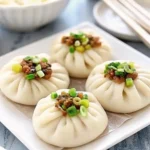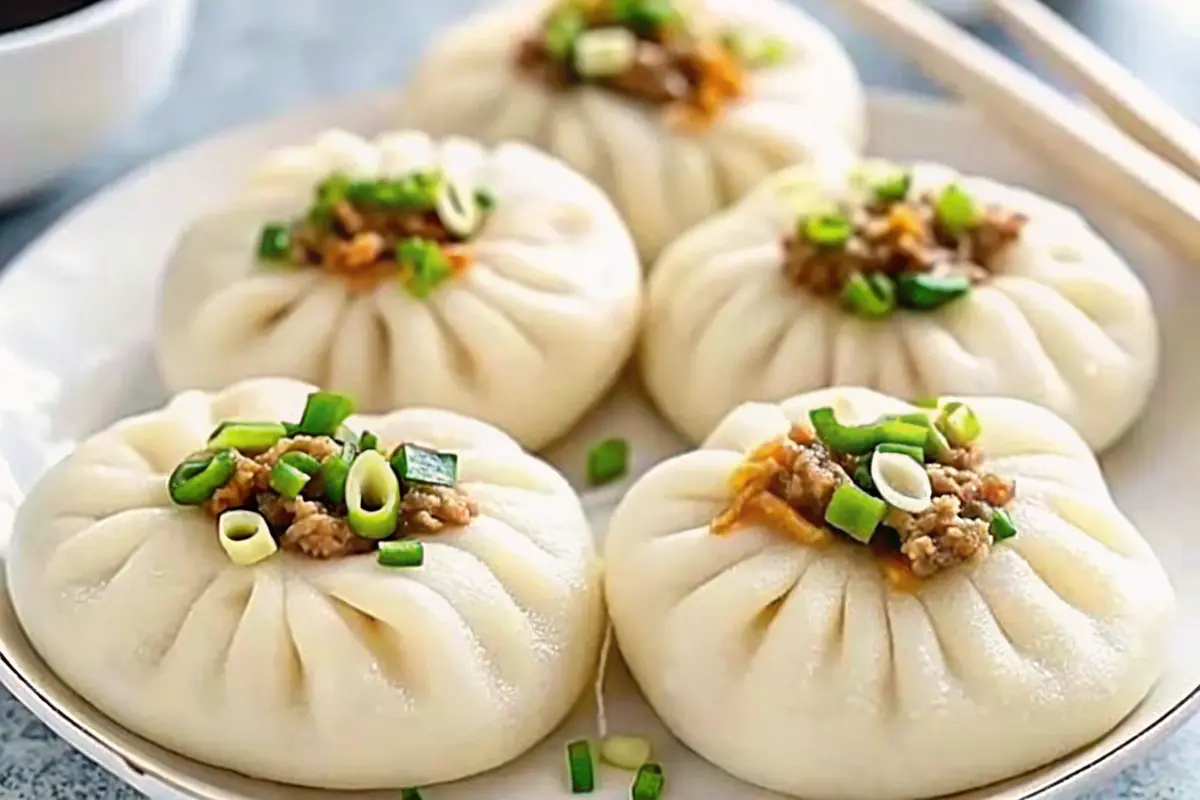Steamed Chinese Meat Buns (Baozi) are one of the most iconic foods in Chinese cuisine. These pillowy, cloud-like buns with savory meat fillings have captured hearts worldwide. They are soft, fluffy, and bursting with flavor, making them a staple at dim sum tables, street food stalls, and family kitchens.
Baozi are not just food—they’re a tradition. From bustling cities in China to kitchens across the globe, baozi remain a beloved comfort dish that connects people to culture and memory.
If you want to understand the roots of this dish and learn how to master it at home, this guide will take you step by step—from history and variations to dough, fillings, and shaping. Along the way, you’ll find tips, techniques, and ideas that will help you create baozi with confidence.
For a detailed historical perspective, you can read more on the Baozi. This provides a fascinating background on how baozi evolved into one of China’s most popular steamed dishes.
History and Origins of Baozi
The story of baozi dates back centuries. According to Chinese folklore, the famed military strategist Zhuge Liang invented mantou (plain steamed buns), which later evolved into baozi when cooks began filling them with meat and vegetables.
Originally, these buns were larger and often eaten as a full meal. Over time, they diversified into smaller dim sum versions, street snacks, and festival foods. Today, baozi are made in countless variations, from pork-filled buns to vegetarian baozi and even dessert versions.
Ingredients Overview: Dough and Filling Essentials
The magic of baozi lies in the balance between fluffy dough and juicy filling. Before diving into the full recipes, here’s a quick breakdown of essentials:
Dough Ingredients
- All-purpose flour (or low-protein flour for extra softness)
- Instant yeast or active dry yeast
- Warm water or milk
- Sugar (for a touch of sweetness and fermentation boost)
- Neutral oil or lard (for softness)
- Pinch of salt
Filling Ingredients (Classic Pork Baozi)
- Ground pork (about 20–30% fat for juiciness)
- Soy sauce (light and dark for depth)
- Shaoxing wine (for aroma)
- Sesame oil
- Ginger and scallions (finely minced)
- White pepper
- Sugar (to balance flavors)
- Cornstarch (for binding and texture)

These core ingredients can be adapted depending on whether you want a traditional pork bun, chicken and vegetable mix, or a vegetarian alternative.
Making the Dough for Baozi
The baozi dough is the heart of this dish. It should be light, airy, and slightly sweet to balance the savory filling. Here’s a step-by-step guide to achieving the perfect dough:
Step 1: Mixing the Dough
- Combine warm water or milk with sugar and yeast. Let sit for 5–10 minutes until foamy.
- In a large bowl, mix flour with salt.
- Add yeast mixture and knead until a shaggy dough forms.
Step 2: Kneading
- Knead by hand for 10–12 minutes or in a stand mixer for 8 minutes.
- The dough should be smooth, elastic, and slightly tacky but not sticky.
- Perform the windowpane test: stretch a small piece—if it doesn’t tear, gluten is well-developed.
Step 3: First Rise
- Place dough in a greased bowl, cover, and let it rise for 1–2 hours, or until doubled.
- Rising time depends on room temperature—warmer environments rise faster.
Step 4: Dividing the Dough
- Punch down the dough, divide into equal pieces (about 50–60g each for medium buns).
- Roll each into a smooth ball and cover with a damp cloth to prevent drying.
Preparing the Meat Filling
The filling must be juicy yet cohesive so it doesn’t leak during steaming.
Classic Pork Filling Recipe
- In a large bowl, combine ground pork, soy sauces, Shaoxing wine, sesame oil, sugar, white pepper, and cornstarch.
- Gradually add cold water (2–3 tbsp), stirring vigorously until the meat mixture becomes sticky and well-bound.
- Mix in minced ginger and scallions.
- Cover and chill for at least 30 minutes to firm up before using.
Tips for Perfect Filling
- Fat ratio: Too lean = dry buns. Aim for 70/30 lean-to-fat.
- Binders: Cornstarch + water create a juicy, cohesive filling.
- Chilling: Makes the filling easier to wrap without leaking.
Tools and Equipment You’ll Need
While baozi can be made with simple tools, having the right equipment improves results:
- Bamboo steamer (traditional, allows steam circulation and absorbs moisture)
- Metal steamer (durable but may drip condensation)
- Steamer liners (perforated parchment or cabbage leaves to prevent sticking)
- Rolling pin (for dough discs)
- Bench scraper (for dividing dough evenly)
Shaping and Assembling Baozi
Shaping baozi is an art form. The goal is to seal the filling inside while creating neat pleats on top.
Step 1: Rolling Out Dough Discs
- Take one dough ball and flatten into a disc.
- Roll edges thinner than the center (so the bun base supports the filling).
Step 2: Filling and Pleating
- Place 1–2 tablespoons of filling in the center.
- Hold dough in one hand, pleat edges with the other.
- Aim for 8–12 pleats, pinching tightly to seal.
- Twist the top knot to finish.
Step 3: Proofing Before Steaming
- Place shaped buns on parchment squares.
- Cover with cloth and let rise for 30–45 minutes until puffy.
Final Proofing
- Let shaped buns rest for 30–45 minutes or until puffy and slightly springy.
- Use a damp cloth to cover buns, preventing drying.
- Test readiness: gently press with a finger—if it springs back slowly, it’s ready.
Steaming Protocol
- Fill a steamer pot with water and bring to a rolling boil.
- Place buns in the steamer, leaving 2–3 cm of space between them to expand.
- Cover tightly to prevent condensation from dripping onto buns.
Avoiding Common Steaming Issues
- Use parchment squares or cabbage leaves under each bun to prevent sticking.
- Maintain medium-high steam—too low = dense buns, too high = collapse.
- Let buns rest 2–3 minutes after steaming before opening the lid.
Troubleshooting Common Baozi Problems
Even experienced cooks face challenges. Here’s how to fix common issues:
- Dense or heavy buns
- Cause: underproofing, low hydration, or overmixing dough
- Fix: ensure proper yeast activation, knead until elastic, and allow sufficient rise
- Filling leaks or watery interiors
- Cause: excess liquid or insufficient binding
- Fix: thicken filling with cornstarch, chill before wrapping
- Buns sticking to steamer
- Cause: no liner or high moisture
- Fix: use parchment, cabbage leaves, or lightly oil the steamer
- Collapsed buns
- Cause: overproofing or high steam temperature
- Fix: steam immediately after proofing, moderate water boil, avoid overfilling
- Pleats or seams opening
- Cause: too much filling or improper sealing
- Fix: reduce filling amount and pinch edges firmly
Popular Variations and Recipe Ideas
Steamed Chinese Meat Buns (Baozi) are versatile. Here are some beloved variations:
Char Siu Bao (Cantonese BBQ Pork Buns)
- Sweet, sticky char siu pork filling
- Steamed in small buns for dim sum
- Slightly golden top for extra appeal
Pork & Vegetable Buns
- Classic household baozi
- Pork combined with cabbage, leeks, or carrots
- Can be adapted to mild or spicy flavors
Soup-Filled Baozi (Xiao Long Bao Style)
- Juicy, broth-filled buns
- Requires gelatinized soup in filling for steaming
- Serve with black vinegar and ginger
Pan-Fried Sheng Jian Bao
- Crispy bottom, soft steamed top
- Ideal street food snack
- Smaller size with dense filling
Vegetarian Options
- Mushrooms, tofu, cabbage, glass noodles
- Bound with cornstarch or egg
- Flavored with soy sauce, sesame oil, and aromatics
Fusion Ideas
- Bao sliders with pulled pork or fried chicken
- Sweet dessert bao with red bean paste or custard

Make-Ahead, Freezing, and Reheating
You can prepare baozi in advance for busy mornings or gatherings:
Freezing
- Raw buns: Arrange on a tray, freeze, then transfer to a bag.
- Cooked buns: Steam first, then freeze.
- Both can last 1–3 months in the freezer.
Reheating
- Steam from frozen: add 3–6 minutes depending on size
- Avoid microwave reheating alone—it can make buns tough
- Oven steaming or double boiler methods help retain fluffiness
Serving, Sauces, and Pairings
Baozi are best enjoyed fresh and warm. Typical accompaniments include:
- Chili oil – adds heat and depth
- Black vinegar – tangy contrast
- Soy-vinegar dip with ginger – classic dim sum pairing
- Hoisin sauce – sweet-salty complement
Steamed Chinese Meat Buns (Baozi) pair well with:
- Chinese teas like jasmine or oolong
- Soups such as hot-and-sour or wonton
- Light side dishes like pickled vegetables
Frequently Asked Questions (FAQs)
What is the difference between baozi and mantou?
- Baozi are filled buns, while mantou are plain steamed buns without filling.
How long do you steam baozi?
- Small: 8–10 minutes, medium: 12–15 minutes, large: 18–25 minutes. Let rest 2–3 minutes after steaming.
Can you freeze baozi and how do you reheat?
- Yes. Freeze raw on a tray, then bag. Steam from frozen, adding a few minutes to cooking time.
Why are my baozi doughs dense?
- Possible reasons: underproofed dough, low hydration, old yeast, or overflouring. Ensure proper proofing and kneading.
Is char siu bao the same as pork bao?
- Char siu bao is a Cantonese BBQ pork variation, whereas pork bao can include various pork-based fillings.
Conclusion
Steamed Chinese Meat Buns (Baozi) are a culinary treasure—soft, fluffy, and filled with delicious savory goodness. By mastering the dough, perfecting the filling, and learning proper steaming techniques, you can recreate authentic baozi in your own kitchen.
Print
Ultimate Guide to Making Steamed Chinese Meat Buns (Baozi)
- Total Time: PT30M
- Yield: 12 buns 1x
- Diet: Gluten Free
Description
These Steamed Chinese Meat Buns (Baozi) are soft, fluffy buns filled with savory, juicy pork filling. Perfect as a snack, appetizer, or meal, they’re a staple of Chinese cuisine and great for sharing at family gatherings or dim sum nights.
Ingredients
For the Dough:
- 2 cups all-purpose flour
- ½ cup warm water
- 1 tsp active dry yeast
- 1 tbsp sugar
- 1 tsp vegetable oil
- Pinch of salt
For the Filling:
- 1 lb ground pork (or chicken)
- 2 green onions, finely chopped
- 2 cloves garlic, minced
- 1 tbsp soy sauce
- 1 tbsp oyster sauce
- 1 tsp sesame oil
- ½ tsp sugar
- ½ tsp ground white pepper
- Optional: grated ginger, 1 tsp
Instructions
- Make the dough:
- In a bowl, dissolve yeast and sugar in warm water. Let sit 5 minutes.
- Add flour, oil, and salt. Knead until smooth, about 8–10 minutes.
- Cover and let rise 1 hour until doubled.
- Prepare the filling:
- Mix ground meat with green onions, garlic, soy sauce, oyster sauce, sesame oil, sugar, and pepper until well combined.
- Assemble the buns:
- Punch down the dough and divide into 12 equal pieces.
- Roll each piece into a circle (~4 inches).
- Place 1–2 tablespoons of filling in the center.
- Pleat the edges and pinch to seal at the top.
- Steam the buns:
- Line a steamer with parchment paper or cabbage leaves to prevent sticking.
- Place buns in the steamer, leaving space for expansion.
- Steam over boiling water for 12–15 minutes.
- Serve:
- Serve hot, with soy sauce or chili sauce for dipping.
- Prep Time: PT15M
- Cook Time: PT15M
- Category: Main Dish
- Method: Steaming
- Cuisine: Chinese
Nutrition
- Serving Size: 1 bun
- Calories: 180kcal
- Sugar: 2g
- Sodium: 360mg
- Fat: 6g
- Saturated Fat: 2g
- Trans Fat: 0g
- Carbohydrates: 22g
- Fiber: 1g
- Protein: 9g
- Cholesterol: 30mg


1 thought on “Ultimate Guide to Making Steamed Chinese Meat Buns (Baozi) — Classic Pork Baozi Recipe & Tips”